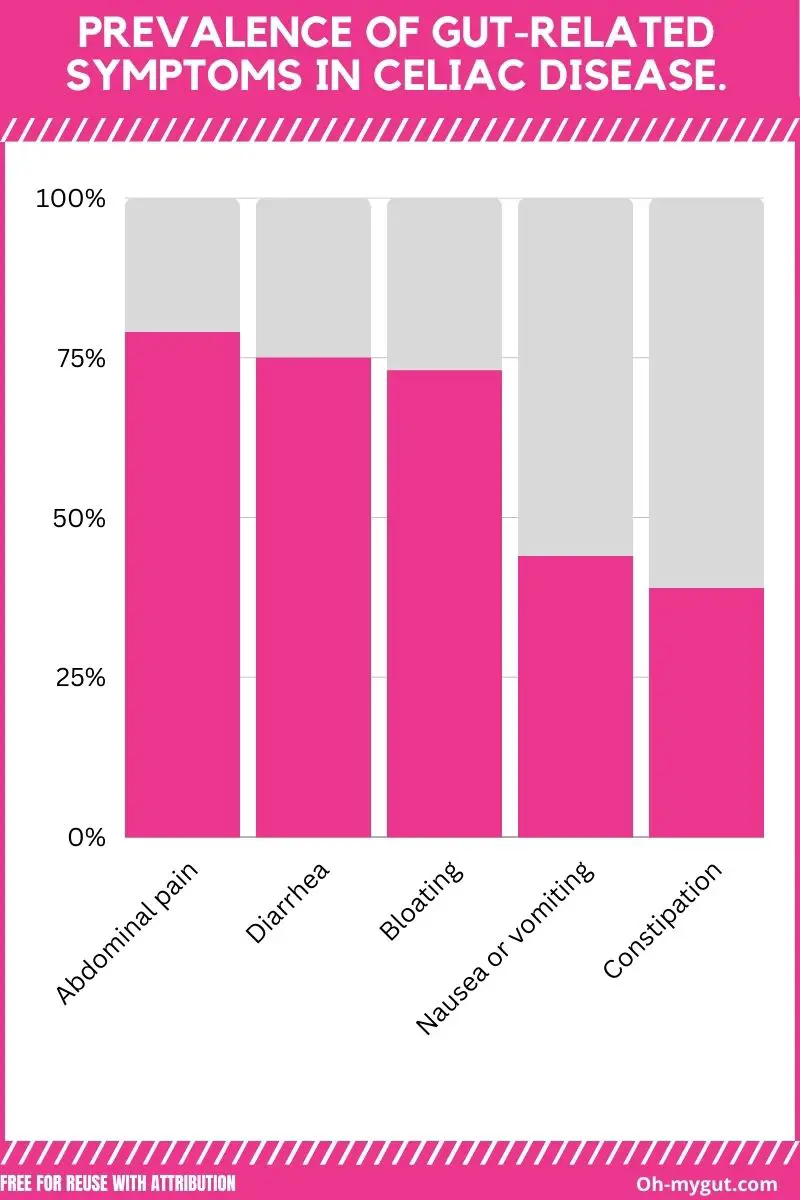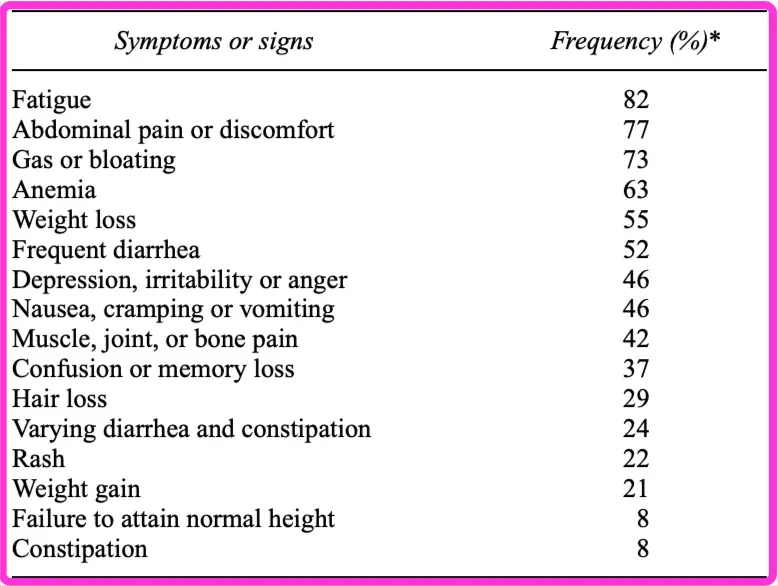Celiac Disease Stomach Pain: Incidence, Location, & Characters
Our content is not intended nor recommended as a substitute for medical advice by your doctor. Use for informational purposes only.
Celiac disease is a common gut disease that may cause recurrent abdominal pain. Celiac disease stomach pain can be mistaken for IBS or another gut disease.
Today, we will explain the causes, characters, and locations of celiac disease abdominal pain. Keep reading for more insights.
1. What is celiac disease?
Celiac disease is an immune-mediated inflammation of the small intestine. It is a reaction to eating gluten (a protein found mainly in wheat, rye, and barley) (reference).
About 1% of the world population has celiac disease (reference). Celiac disease leads to marked inflammation of the small intestinal lining (the part responsible for food absorption).
The inflammation leads to impaired absorption of many nutrients and elements, stomach pain, and diarrhea.
High-risk groups include (reference):
- First and second-degree relatives of a patient with celiac disease.
- Patients with type 1 diabetes (insulin-dependent diabetes mellitus).
- Autoimmune thyroiditis.
- Down and Turner syndrome.
- Patients with allergic skin conditions (atopic dermatitis).
- Pulmonary hemosiderosis.
Celiac disease presents with three main groups of symptoms:
- Intestinal symptoms: diarrhea, stomach pain, bloating, etc.
- Malabsorption symptoms: Severe anemia, weight loss, bone loss (osteomalacia), etc.
- Extra-intestinal symptoms & associated conditions: Dermatitis, headache, Type 1 DM, Thyroid disease, GERD, elevated liver enzymes, menstrual issues, etc.
2. How common is stomach pain with celiac disease?
Celiac disease occurs primarily in children. However, it can occur in adults as well.
Studies show that many patients with celiac disease are asymptomatic or have minor gut-related symptoms.
Also, abdominal pain with more prevalent in children than in adults with celiac disease.
One study found that celiac disease stomach pain is found in about 79% of patients with celiac disease (reference).
So, stomach pain (abdominal pain) is a common presentation of celiac disease, especially in children.

3. Celiac disease stomach pain location & Characters.
Celiac disease stomach pain is often mild and diffuse abdominal pain. It is often caused by intestinal inflammation, excess gas, and fat malabsorption.
Patients with celiac disease often suffer from generalized discomfort and upper or lower abdominal pain. The pain often is triggered by eating gluten (in wheat, rye, or barley).
There is no characteristic location of celiac disease or stomach pain. The pain can be either lower or upper abdominal or generalized all over the abdomen.
You cannot diagnose or suspect celiac disease based on a specific stomach pain location. Celiac disease is suspected based on a combination of gastrointestinal and non-gastrointestinal symptoms.
Also, the duration of stomach pain matters. Acute short-lived stomach pain and diarrhea are often due to infection rather than celiac disease. Celiac disease stomach pain is often recurrent or chronic for long durations.
If you want to know how to suspect celiac disease in a child or an adult, read the next section carefully.
The following is a summary of some characteristics of stomach pain associated with celiac disease:
- Onset: the onset of pain is often related to eating gluten-containing foods (wheat, rye, or barley).
- Course: celiac disease is often chronic or recurrent every day or every few days.
- The severity of the pain: Celiac stomach pain is often mild to moderate in severity. Minor colics or discomfort is the most common type.
- Location of pain: often generalized; some people may feel the pain more in the lower abdomen.
- Associated abdominal symptoms: diarrhea and bloating; sometimes, patients may suffer from constipation alternating with diarrhea.
- Other associated symptoms: failure to thrive in children, skin rashes, bone pain, easy fractures, headaches,
- The pain improves dramatically when you cut gluten from your diet (within a few days).
4. When to suspect celiac disease in a patient with unexplained stomach pain?
As we explained before, celiac disease stomach pain has no characteristic features or locations that are specific to celiac disease.
So, I will explain how to suspect celiac disease in patients with unexplained stomach pain.
The suspicion of the disease depends on a combination of:
- Risk factors.
- Intestinal symptoms.
- Extra-intestinal symptoms and related conditions.
A. Presence of risk factors of celiac disease.
In patients with chronic or recurrent stomach pain, the first suspicion of celiac disease should be based on the presence of risk factors such as:
- Having a first or second-degree relative with celiac disease.
- Being a child or younger adult.
- Being a type-1 diabetes patient.
- Having down or tuner syndrome.
- Having a thyroid disease.
- Personal or family history of atopic dermatitis (chronic skin allergy or eczema).
B. Symptoms:
The table below summarizes all the symptoms of celiac disease (& their frequency) (reference). Celiac disease is more likely when you have multiple symptoms/associated conditions.
The most common symptoms associated with celiac disease stomach pain include:
- Generalized fatigue.
- Gas and bloating.
- Bloating.
- Anemia (easy fatigue, pallor, shortness of breath, headache, and fast heartbeats).
- Weight loss.
- Frequent diarrhea (bulky, foul-smelling).
- Depression, irritability, or anger.
- Nausea or vomiting g.
- Skin rash.
- Muscle, joint, or bone pain.
- Confusion or memory loss.
- Hair loss.
- Failure to thrive (in toddlers and children).

C. Associated conditions:
The presence of one or more of these conditions increases the odds of celiac disease:
- Type 1 diabetes mellitus.
- Autoimmune thyroid disease.
- Down syndrome.
- Tuner’s syndrome.
- Atopic dermatitis (Eczema).
- Unexplained liver disease (jaundice, elevated liver enzymes).
- Unexplained heart disease such as idiopathic cardiomyopathy and myocarditis.
- Chest conditions such as idiopathic pulmonary hemosiderosis.
- Infertility, recurrent abortions.
- Persistent oral ulcers and dental erosions.
5. How is celiac disease diagnosed?
When your doctor suspects celiac disease (based on symptoms and associated conditions), he will diagnose the disease using one or more of the following investigations:
- Blood testing for antibodies (such as EMA-IgA, tTG, AGA-IgA, AGA IgG, DGP-IgA, etc.).
- Upper GI endoscopy with biopsy from the first part of the small intestine (the duodenum or the jejunum).
- Genetic testing.
- Routine investigations such as CBC (Complete blood count), iron profile, serum vitamin D, and others will help to determine the severity of the celiac disease.
- Evidence-based
- Written by a doctor.






